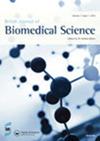A novel nonsense variation in the albumin gene (c.1309 A>T) causing analbuminaemia.
IF 2.7
4区 医学
Q2 MEDICAL LABORATORY TECHNOLOGY
British Journal of Biomedical Science
Pub Date : 2021-07-01
Epub Date: 2020-10-30
DOI:10.1080/09674845.2020.1819632
引用次数: 3
Abstract
Congenital analbuminaemia (OMIM # 616,000) is a rare autosomal recessive disorder, characterized by the nearcomplete absence, or very low levels, of serum albumin. The clinical diagnosis is usually made by serum protein electrophoresis and immunonephelometry [1,2]. However, since albumin levels vary depending on the method for their quantification, and as hypoalbuminaemia may be caused by many different clinical conditions, the mutation analysis of the albumin gene is mandatory in establishing the diagnosis of congenital analbuminaemia [1,2]. The condition is relatively benign in adulthood because the compensatory increase of other plasma proteins does partly take over the functions of albumin. Most adult analbuminaemic individuals are either asymptomatic or oligosymptomatic, with moderate clinical symptoms such as mild oedema, hypotension, and fatigue [1,2]. However, almost all show hypercholesterolaemia and elevated LDL-cholesterol levels, likely increase the risk of premature atherosclerosis and cardiovascular disease, although lack of an adequate follow-up data brings difficulty in confirming this link [2–4]. Furthermore, albumin concentration is considered a remarkably strong prognostic indicator of morbidity and mortality, especially in the elderly and in hospitalized patients [2]. In contrast with the mild symptoms in adulthood, congenital analbuminaemia can have serious consequences during the prenatal period, causing miscarriages and preterm birth, and can lead to death in early childhood, mainly from fluid retention and infections of the lower respiratory tract [2,5,6]. The rarity of the trait has been attributed to the fact that only a few analbuminaemic individuals survive past the preand perinatal period [2,5,6]. A confirmation of this hypothesis is provided by a recent survey, showing that congenital analbuminaemia is the second most common direct cause of deaths in children younger than 5 years [7]. The case白蛋白基因中一种新的无义变异(约1309年)A>T)引起白蛋白血症。
本文章由计算机程序翻译,如有差异,请以英文原文为准。
求助全文
约1分钟内获得全文
求助全文
来源期刊

British Journal of Biomedical Science
医学-医学实验技术
CiteScore
4.40
自引率
15.80%
发文量
29
审稿时长
>12 weeks
期刊介绍:
The British Journal of Biomedical Science is committed to publishing high quality original research that represents a clear advance in the practice of biomedical science, and reviews that summarise recent advances in the field of biomedical science. The overall aim of the Journal is to provide a platform for the dissemination of new and innovative information on the diagnosis and management of disease that is valuable to the practicing laboratory scientist.
 求助内容:
求助内容: 应助结果提醒方式:
应助结果提醒方式:


